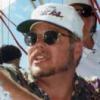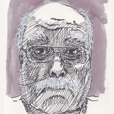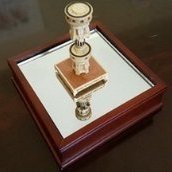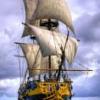MORE HANDBOOKS ARE ON THEIR WAY! We will let you know when they get here.
×
-
Posts
938 -
Joined
-
Last visited
Reputation Activity
-
 shipmodel got a reaction from Mark B Snider in Swan 42 by shipmodel - FINISHED - one-design racing yacht
shipmodel got a reaction from Mark B Snider in Swan 42 by shipmodel - FINISHED - one-design racing yacht
Now I turned back to the lower hull. It was refined with templates and progressively finer sanding blocks. After the 400 grit level I sealed it with Minwax Wood Hardener. This product is designed to strengthen rotted wood, but I have found it to be perfect for sealing wood where I want a truly smooth surface. The only drawback is that the wood becomes so hard that it is quite difficult to remove more than just a small amount - don't aske me how I know. I now hold off on using it until I am quite satisfied that I have the proper shape.
After the hardener dried overnight it was sanded smooth to remove the raised grain, and the first coat of Krylon auto primer was sprayed on. This revealed that there were small imperfections where the various lifts had been joined to each other. These were filled by painting the entire lower hull with a thin solution of small-grained plaster. After sanding with a sanding block you can see where the plaster has filled the voids. The plaster was hardened and the next primer coat was applied, then sanded smooth. Ultimately, seven coats of primer were laid on and progressively sanded off with up to 1000 grit paper.
The keel fin and bulb were similarly shaped, hardened, filled and sanded. Because the keel fin is so thin its connection points with the lower hull above and the keel bulb below would be incredibly fragile. I therefore planned for and fitted a steel pin that goes into the hull about 2 inches and down below the keel bulb about the same amount. I don't know how it will be displayed, but this should give them a great deal of flexibility in choosing the mounting for the model.
So here is my progress to date. The three major components - upper hull, lower hull, and keel - can be stacked to see how they line up and to refine them as needed. More as the model develops.
Be well
Dan Pariser
-
 shipmodel got a reaction from MSzwarc in Swan 42 by shipmodel - FINISHED - one-design racing yacht
shipmodel got a reaction from MSzwarc in Swan 42 by shipmodel - FINISHED - one-design racing yacht
Now I turned back to the lower hull. It was refined with templates and progressively finer sanding blocks. After the 400 grit level I sealed it with Minwax Wood Hardener. This product is designed to strengthen rotted wood, but I have found it to be perfect for sealing wood where I want a truly smooth surface. The only drawback is that the wood becomes so hard that it is quite difficult to remove more than just a small amount - don't aske me how I know. I now hold off on using it until I am quite satisfied that I have the proper shape.
After the hardener dried overnight it was sanded smooth to remove the raised grain, and the first coat of Krylon auto primer was sprayed on. This revealed that there were small imperfections where the various lifts had been joined to each other. These were filled by painting the entire lower hull with a thin solution of small-grained plaster. After sanding with a sanding block you can see where the plaster has filled the voids. The plaster was hardened and the next primer coat was applied, then sanded smooth. Ultimately, seven coats of primer were laid on and progressively sanded off with up to 1000 grit paper.
The keel fin and bulb were similarly shaped, hardened, filled and sanded. Because the keel fin is so thin its connection points with the lower hull above and the keel bulb below would be incredibly fragile. I therefore planned for and fitted a steel pin that goes into the hull about 2 inches and down below the keel bulb about the same amount. I don't know how it will be displayed, but this should give them a great deal of flexibility in choosing the mounting for the model.
So here is my progress to date. The three major components - upper hull, lower hull, and keel - can be stacked to see how they line up and to refine them as needed. More as the model develops.
Be well
Dan Pariser
-
 shipmodel got a reaction from Nirvana in Swan 42 by shipmodel - FINISHED - one-design racing yacht
shipmodel got a reaction from Nirvana in Swan 42 by shipmodel - FINISHED - one-design racing yacht
Now I turned back to the lower hull. It was refined with templates and progressively finer sanding blocks. After the 400 grit level I sealed it with Minwax Wood Hardener. This product is designed to strengthen rotted wood, but I have found it to be perfect for sealing wood where I want a truly smooth surface. The only drawback is that the wood becomes so hard that it is quite difficult to remove more than just a small amount - don't aske me how I know. I now hold off on using it until I am quite satisfied that I have the proper shape.
After the hardener dried overnight it was sanded smooth to remove the raised grain, and the first coat of Krylon auto primer was sprayed on. This revealed that there were small imperfections where the various lifts had been joined to each other. These were filled by painting the entire lower hull with a thin solution of small-grained plaster. After sanding with a sanding block you can see where the plaster has filled the voids. The plaster was hardened and the next primer coat was applied, then sanded smooth. Ultimately, seven coats of primer were laid on and progressively sanded off with up to 1000 grit paper.
The keel fin and bulb were similarly shaped, hardened, filled and sanded. Because the keel fin is so thin its connection points with the lower hull above and the keel bulb below would be incredibly fragile. I therefore planned for and fitted a steel pin that goes into the hull about 2 inches and down below the keel bulb about the same amount. I don't know how it will be displayed, but this should give them a great deal of flexibility in choosing the mounting for the model.
So here is my progress to date. The three major components - upper hull, lower hull, and keel - can be stacked to see how they line up and to refine them as needed. More as the model develops.
Be well
Dan Pariser
-
 shipmodel got a reaction from bbrockel in Swan 42 by shipmodel - FINISHED - one-design racing yacht
shipmodel got a reaction from bbrockel in Swan 42 by shipmodel - FINISHED - one-design racing yacht
Now I turned back to the lower hull. It was refined with templates and progressively finer sanding blocks. After the 400 grit level I sealed it with Minwax Wood Hardener. This product is designed to strengthen rotted wood, but I have found it to be perfect for sealing wood where I want a truly smooth surface. The only drawback is that the wood becomes so hard that it is quite difficult to remove more than just a small amount - don't aske me how I know. I now hold off on using it until I am quite satisfied that I have the proper shape.
After the hardener dried overnight it was sanded smooth to remove the raised grain, and the first coat of Krylon auto primer was sprayed on. This revealed that there were small imperfections where the various lifts had been joined to each other. These were filled by painting the entire lower hull with a thin solution of small-grained plaster. After sanding with a sanding block you can see where the plaster has filled the voids. The plaster was hardened and the next primer coat was applied, then sanded smooth. Ultimately, seven coats of primer were laid on and progressively sanded off with up to 1000 grit paper.
The keel fin and bulb were similarly shaped, hardened, filled and sanded. Because the keel fin is so thin its connection points with the lower hull above and the keel bulb below would be incredibly fragile. I therefore planned for and fitted a steel pin that goes into the hull about 2 inches and down below the keel bulb about the same amount. I don't know how it will be displayed, but this should give them a great deal of flexibility in choosing the mounting for the model.
So here is my progress to date. The three major components - upper hull, lower hull, and keel - can be stacked to see how they line up and to refine them as needed. More as the model develops.
Be well
Dan Pariser






